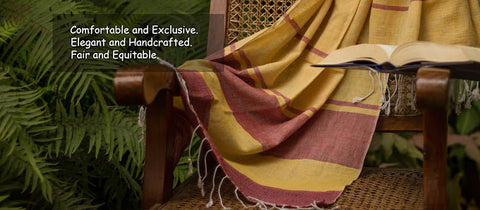Inspired by the artisans of a village near Lucknow, clothing brand Baragaon Weaves is all about reviving handloom and rekindling buyer interest in the handmade.

Handmade fabrics by Baragaon Weaves
If ever there was a ghar wapsi story in the truest sense, this is it. A big-city man with small-town roots, who works for an NGO on issues related to health, education and disaster management in rural Maharashtra, Bihar and Kashmir, visits his ancestral village in Uttar Pradesh for a family function in 2015. Here, he is confronted by the plight of local handloom weavers, who are facing penury in the light of rampant mechanisation. “You work all over to help the underprivileged, but you never do anything for your own village,” they tell him. That’s when the idea for Baragaon Weaves came into being for social activist Jamal Kidwai, who named the brand after his village, Baragaon, some 40 km from Lucknow.
Struck by this realisation and spurred into action, Delhi-based Kidwai (54), decided to delve deeper and figure out what kind of project could be started in Baragaon. Most of the villagers were handloom weavers who were rapidly losing their livelihood to power loom. They needed to be rehabilitated fast if their craft, and they themselves, were to be brought back from the brink of ruin. Their looms needed to be loaded again, that too profitably.
Kidwai now knew the problem, but not the solution. “My domain was health and education, not craft or design. I still decided to forge ahead with a pilot project, calling it Baragaon Weaves, where I invested my own money and asked the weavers to come up with yardage in five colours of 100 meters each,” he recalls. They wove it quickly and sent it to him in Delhi. Not knowing how to market, he took it to a Dastkar exhibition. Unfortunately, it barely sold. Fortunately, the products were spotted by leading e-commerce brand jaypore.com. They not only liked the products but also gave a bulk order of 1,000 metres. That was all the push he needed to get going.
Since Kidwai had no clue about weaving technology or design, he hired a young, fresh-out-of-NIFT intern, Shreya Bhattacharya. She is the one who created new designs, upgraded the weavers’ skills, and coaxed and cajoled them to move beyond running fabrics and diversify into saris and dupattas. Resistant at first, they slowly came around once the products started to sell. By then, a friend and financial journalist, Udayan Mukherjee, joined in too and together, they registered Bargaon Weaves as a business in 2017.
Meanwhile, Kidwai, who during his NGO days had reconstructed homes of Kashmiri weavers damaged during floods, got in touch with them again––this time to market the shawls they wove. That’s how pashmina came into the picture and is now a major part of the Baragaon Weaves product line. The brand also reached out to women embroidery artisans as well. In Uttar Pradesh, it engaged chikan workers to embroider their sarees, kurtas and dupattas. In Kashmir, it was sozni embroidery, all of which is done on handloom cotton fabric and pashmina.
The popularity of its products led Kidwai to set up shop in Delhi’s tony Hauz Khas Market. He, however, had to close it down during the pandemic, and now retails through the brand’s website (www.baragaonweaves.com), as well as other portals such as itokri. It also holds exhibitions at its studio in Delhi’s Jamia Nagar, besides undertaking bulk orders from other stores. And in between all this, Kidwai proudly says that they have been able to more than double their weavers’ wages. The objective of starting Baragaon Weaves was two-fold—to provide dignified wages to weavers, and to make handloom fashionable to ensure continued growth in demand. Judging by the journey thus far, safe to say it has achieved both.
This content is originally posted at The New Indian Express.
Blogs you might also like:
Chanderi Weave: A Delicate Work Of Stunning Intricacy
Kala Cotton : The Future Fabric from Kutch
The Prehistoric Period Interest in Indian Muslin Fabric
 Verified Purchase
Verified Purchase














































































Leave a comment (all fields required)